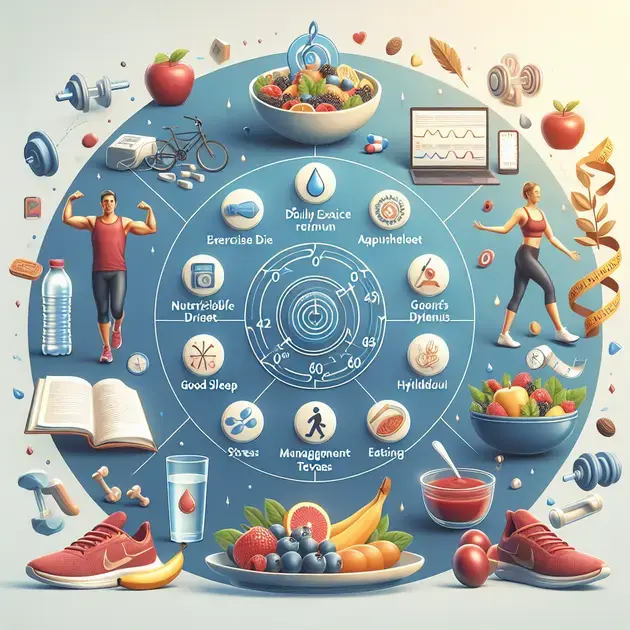Maintaining healthy glucose levels is essential for overall wellbeing. In today’s fast-paced world, where sugary treats and processed foods are easily accessible, it can be challenging to keep blood sugar in check. However, with the right strategies and lifestyle changes, it is possible to achieve optimal glucose levels.
Exercise plays a crucial role in lowering glucose levels. Research has shown that physical activity helps the body use insulin more efficiently, resulting in better blood sugar control. Moreover, regular exercise can also help prevent insulin resistance, a key factor in the development of Type 2 diabetes.

Strategies for Lowering Glucose Levels Through Exercise
Regular physical activity is essential for managing and lowering glucose levels in individuals with diabetes. One effective strategy is aerobic exercise, such as walking, cycling, or swimming. These activities help increase the body’s sensitivity to insulin, allowing for better glucose uptake by cells.
A useful app for tracking your exercise routine and glucose levels is MyFitnessPal. This app allows you to log your workouts and meals, providing insights into how your physical activity affects your blood sugar levels. It also offers personalized recommendations for achieving your fitness and health goals.
In addition to aerobic exercise, strength training can also play a crucial role in lowering glucose levels. Activities like weight lifting or bodyweight exercises help increase muscle mass, which can lead to improved insulin sensitivity and glucose regulation.
Another helpful tip is to incorporate flexibility exercises, such as yoga or stretching, into your routine. These activities can help reduce stress levels, which in turn positively impact insulin efficiency and glucose metabolism.
Remember to consult with your healthcare provider before starting any new exercise regimen, especially if you have diabetes or other medical conditions. They can provide personalized recommendations and guidelines based on your individual health status.
The Impact of Physical Activity on Insulin Efficiency
Regular physical activity not only helps lower glucose levels but also plays a significant role in improving insulin efficiency. When you engage in exercise, your muscles require more glucose for energy, leading to increased insulin sensitivity and uptake of glucose from the bloodstream.
An excellent tool for monitoring your insulin levels and physical activity is the Blood Sugar Tracker app. This app allows you to record your blood sugar readings, track your exercise sessions, and analyze how different activities affect your insulin levels over time.
Furthermore, consistent physical activity can help reduce insulin resistance, a common issue in individuals with type 2 diabetes. By enhancing insulin efficiency, you can better regulate your blood sugar levels and decrease the risk of complications associated with diabetes.
High-intensity interval training (HIIT) is a particularly effective exercise method for improving insulin sensitivity. This type of workout involves alternating between short bursts of intense activity and brief periods of rest, leading to better glucose control and overall metabolic health.
Make sure to set achievable fitness goals and gradually increase the intensity and duration of your workouts to maximize the benefits of physical activity on insulin efficiency. Stay consistent and listen to your body’s needs to maintain a sustainable exercise routine.
Preventing Type 2 Diabetes with Regular Exercise
One of the most effective ways to prevent type 2 diabetes is by engaging in regular exercise. Physical activity helps maintain a healthy weight, improve insulin sensitivity, and reduce the risk of developing insulin resistance, a precursor to diabetes.
The Couch to 5K app is a great resource for beginners looking to start a structured running program. By following the app’s training plan, you can gradually build up your endurance and cardiovascular fitness, lowering your overall risk of developing type 2 diabetes.
Incorporating both aerobic and strength-training exercises into your routine is key to preventing diabetes. Cardiovascular activities like running, cycling, or dancing help burn calories and improve insulin function, while strength training builds lean muscle mass and enhances metabolic health.
Additionally, maintaining a balanced diet rich in fruits, vegetables, whole grains, and lean proteins complements your exercise regimen and further reduces the risk of type 2 diabetes. Apps like MyPlate can help you track your daily food intake and ensure you’re meeting your nutritional needs.
By prioritizing regular physical activity, healthy eating habits, and monitoring your health markers with the support of digital tools, you can significantly decrease your likelihood of developing type 2 diabetes and enjoy a higher quality of life.

Effective Ways to Manage Blood Sugar Levels Naturally
Managing blood sugar levels naturally is crucial for overall health and well-being. By incorporating simple yet effective strategies into your daily routine, you can better control your glucose levels and reduce the risk of health complications. Here are some proven methods to help you effectively manage your blood sugar levels:
1. Regular Exercise
Engaging in regular physical activity is one of the most effective ways to manage blood sugar levels naturally. Exercise helps your body utilize glucose for energy, which can improve insulin sensitivity and reduce blood sugar levels. Aim for at least 30 minutes of moderate exercise most days of the week, such as walking, cycling, or swimming.
2. Balanced Diet
A balanced diet rich in whole foods like fruits, vegetables, whole grains, and lean proteins can help regulate blood sugar levels. Avoid sugary drinks and processed foods high in refined carbohydrates. Opt for fiber-rich foods that can slow down glucose absorption and promote stable blood sugar levels.
3. Proper Hydration
Staying hydrated is essential for managing blood sugar levels. Drinking an adequate amount of water throughout the day can help your body flush out excess sugar in the blood through urine. Aim to drink at least 8-10 glasses of water daily and limit the intake of sugary beverages.
4. Sufficient Sleep
Prioritizing good sleep hygiene is important for blood sugar management. Lack of sleep can disrupt hormone levels that regulate glucose metabolism, leading to fluctuations in blood sugar levels. Aim for 7-9 hours of quality sleep each night to support overall health and blood sugar control.
5. Stress Management
Chronic stress can impact blood sugar levels by triggering the release of cortisol, a stress hormone that can increase glucose production in the body. Practice stress-reducing activities such as yoga, meditation, or deep breathing exercises to help manage stress and improve blood sugar control.
Nutritional Strategies for Balancing Glucose Levels
Implementing proper nutritional strategies is essential for balancing glucose levels and promoting overall health. By making smart food choices and adopting healthy eating habits, you can support your body’s ability to regulate blood sugar levels naturally. Here are some key nutritional strategies to help balance glucose levels:
1. Emphasize Complex Carbohydrates
Include complex carbohydrates in your diet, such as whole grains, legumes, and starchy vegetables. These foods are rich in fiber and digested more slowly, leading to gradual glucose release and better blood sugar control. Limit intake of simple carbohydrates like sugary snacks and processed foods.
2. Monitor Portion Sizes
Be mindful of portion sizes to prevent spikes in blood sugar levels. Eating large meals can overwhelm your body’s ability to process glucose, leading to fluctuations in blood sugar. Opt for smaller, balanced meals throughout the day to help maintain stable glucose levels.
3. Include Protein and Healthy Fats
Incorporate lean proteins and healthy fats into your meals to help balance glucose levels. Protein and fats can slow down the absorption of carbohydrates, preventing rapid spikes in blood sugar. Choose sources like nuts, seeds, fish, and avocados for a well-rounded and blood sugar-friendly diet.
4. Limit Added Sugars
Avoid foods and beverages high in added sugars, as they can cause sudden spikes and crashes in blood sugar levels. Check food labels for hidden sugars and opt for natural sweeteners like stevia or monk fruit when needed. Focus on whole, unprocessed foods to minimize sugar intake.
5. Stay Consistent with Meal Timing
Maintain a regular eating schedule to help stabilize blood sugar levels throughout the day. Skipping meals or eating irregularly can disrupt glucose regulation and lead to imbalances in blood sugar. Aim for consistent meal timing and spacing to support optimal blood sugar control.
Mindful Eating Habits for Improving Insulin Sensitivity
Cultivating mindful eating habits can contribute to improved insulin sensitivity and better blood sugar management. By paying closer attention to your food choices, eating behaviors, and hunger cues, you can support overall metabolic health and enhance insulin function. Here are some mindful eating habits to help improve insulin sensitivity:
1. Slow Down and Chew Thoroughly
Take your time to eat and chew your food slowly and thoroughly. This can help improve digestion, nutrient absorption, and satiety signals that regulate food intake. Chewing food well also promotes better blood sugar control by aiding in the breakdown of carbohydrates.
2. Focus on Balanced Meals
Create balanced meals that include a mix of carbohydrates, proteins, and fats to support steady glucose levels. Balancing your macronutrients can prevent rapid spikes in blood sugar and optimize insulin sensitivity. Aim for variety and nutrient density in your meals for better metabolic health.
3. Pay Attention to Hunger and Fullness
Listen to your body’s hunger and fullness cues to guide your eating habits. Avoid emotional or mindless eating by checking in with your hunger levels before and during meals. Eating when you’re truly hungry and stopping when you’re satisfied can help regulate blood sugar and prevent overeating.
4. Minimize Distractions While Eating
Avoid distractions like screens or work-related activities while eating to promote mindful awareness of your meals. Focus on the taste, texture, and experience of eating to enhance satisfaction and improve digestion. Being present during meals can also support better insulin sensitivity and blood sugar regulation.
5. Practice Gratitude and Mindfulness
Cultivate a mindset of gratitude and mindfulness around food to foster a positive relationship with eating. Appreciate the nourishing qualities of your meals and savor each bite mindfully. Mindful eating practices can help reduce stress, improve digestion, and enhance insulin sensitivity for better blood sugar management.
Conclusion
Managing blood sugar levels naturally is essential for overall health and well-being. By incorporating regular exercise, a balanced diet, proper hydration, sufficient sleep, and stress management into your daily routine, you can effectively control your glucose levels and reduce the risk of health complications.
Key Nutritional Strategies
When it comes to balancing glucose levels, emphasizing complex carbohydrates like whole grains and legumes, monitoring portion sizes, including protein and healthy fats, limiting added sugars, and staying consistent with meal timing are crucial factors. These strategies help regulate blood sugar levels and support optimal metabolic health.
Mindful Eating Habits for Insulin Sensitivity
Cultivating mindful eating habits such as slowing down and chewing thoroughly, focusing on balanced meals, paying attention to hunger and fullness cues, minimizing distractions while eating, and practicing gratitude and mindfulness can contribute to improved insulin sensitivity and better blood sugar management. By adopting these habits, you can enhance your overall metabolic health and support effective glucose regulation.